Overview: A list of Perry Mason novels, including some plot descriptions, notes on recurring characters, and a few photos of book covers.
I’m a fan of the Perry Mason novels by Erle Stanley Gardner. I’ve read all 80 of the novels published in Gardner’s lifetime, plus the 2 novels published posthumously; I’ve also read the 3 short stories featuring Perry Mason.
I’m particularly interested in the way the recurring characters are treated. During all those years, the character of Mason never ages, and his relationships with the other recurring characters remains mostly static. But there are some subtle changes in relationships. E.g., in a few novels Mason kisses Della Street and once or twice they even talk about marriage, but in other novels their relationship is less intimate.
Gardner was a one-man fiction-writing factory, sometimes churning out half a dozen novels a year, along with short stories and non-fiction pieces. He does have some favorite plot devices — murder in a motel, murder over mining rights, murder over inheritance, etc. Yet in spite of this, the majority of Gardner’s plots show at least some imagination and creativity, and they are rarely boring.
Since Gardner was a trial lawyer himself, the novels sometimes contain interesting legal matters. Gardner places Perry Mason in a variety of legal settings, including preliminary trials, jury trials, county and Federal courtrooms, coroner’s hearing, conferences in a judge’s chambers, etc. Occasionally, Gardner cites actual California state law. In fact, there’s enough legal interest in the books that the publishing arm of the American Bar Association has reprinted a dozen or so of the novels.
I’m also interested in the Perry Mason books is the way they depict (or don’t depict) the times they were written in. Gardner wrote the novels from 1933 through 1969, a period that saw quite a bit of social change, and the novels reflect this to some degree. E.g., the novels published during World War II contain references to the war; beatniks appear in some of the 1950s novels; the novels published after the Supreme Court’s Miranda ruling refer to that ruling; etc. Mostly, though, the novels depict a white middle class and upper middle class American culture that does not change. I’ll make passing mention of this under descriptions of the plot.
Below you will find a checklist of all the Perry Mason novels and stories by Gardner. I’m slowly adding commentary for each novel on the above topics: recurring characters, plot devices, and legal matters. I’ve included a dozen or so photos of books and book covers, but I will not include a cover image for every title.
If you’d like to contribute to this project, please email me or leave a comment.

Novels
1. The Case of the Velvet Claws
Morrow: Mar., 1933
Recurring characters:
Perry Mason is described for the first time in the opening pages of this novel: “Autumn sun beat against the window. Perry Mason sat at his desk. There was about him the attitude of one who is waiting. His face in repose was like the face of a chess player. Only the eyes changed expression. He gave the impression of being a thinker and a fighter….”
Della Street, Mason’s secretary, appears soon thereafter: “Della Street was slim of figure, steady of eye; a young woman of approximately twenty-seven, who gave the impression of watching life with keenly appreciative eyes and seeing far below the surface.” In chapter 16, she says she has been working for Mason for five years. In the second half of the novel, Della expresses doubts in the way Perry is conducting his defense, the only time she expresses serious doubts about his work as a lawyer.
Paul Drake, who runs the detective agency that Parry Mason always hires, also makes his first appearance: “Mason was still standing there when the door to the outer office opened and a tall man, with drooping shoulders and a head that was thrust forward on a long neck, came into the outer office. He regarded Della Street with protruding glass eyes that held a perpetual expression of droll humor, smiled at her, turned to Mason and said, ‘Hello Perry.'”
The police officers, detective Sidney Drumm and Sergeant Hoffman, never appear in any other books.
Plot devices:
Legal matters:
No courtroom scene in the book.
Other notes:
By comparison with later Perry Mason novels, this book is long and bloated. The prose sounds more like the hard-boiled style of pulp magazines like Black Mask, and seems more dated than the later novels.
2. The Case of the Sulky Girl
Morrow: Sept., 1933
Recurring characters:
Perry Mason’s law clerk is Frank Everly. In this book, he takes on the role of doubting Perry’s defense, but Della tells him that she has already bet half her paycheck with Paul Drake that Perry will win the case (thus revealing that Paul had doubts about Perry’s abilities).
For the first time, Paul Drake assumes his favorite position in Mason’s office:
“He sat in the big high-backed leather chair in Parry Mason’s office, and turned sideways, so that his long legs were crossed over the right hand arm of the chair. A cigarette was in his mouth, hanging pendulously from his lower lip.” (Chapter XII)
Police officers and police detectives have only minor roles.
The prosecuting deputy from the D.A.’s office is Claude Drumm (the D.A.’s name is not mentioned). Drumm will appear in a few subsequent books.
Plot devices:
Legal matters:
This book contains Perry Mason’s first trial scene.
3. The Case of the Lucky Legs
Morrow: Feb., 1934
Recurring characters:
Plot devices:
Legal matters:
4. The Case of the Howling Dog
Serialized: Liberty Magazine, Jan.-Mar., 1934
Morrow: June, 1934
Recurring characters:
In chapter 19, law clerk Frank Everly returns to serve as a foil for Perry Mason, so that Perry can offer his philosophy of conducting a powerful defense.
Claude Drumm is again the prosecuting attorney. Perry Mason seems to get along well with the D.A.’s office in chapter 2, but by the end of the novel he winds up making Claude Drumm look foolish.
In this novel, Della Street is still addressing Paul Drake as “Mr. Drake” (in the later books, she calls him “Paul”).
Plot devices:
A somewhat unsatisfying subplot involves Ah Wong, an illegal Chinese immigrant. Wong’s employer tells federal immigration officers that Wong is in the country illegally, so that Wong will not be able to testify in the murder trial. Perry Mason subpoenas Wong, but winds up not needing his testimony; we never learn what happens to Wong in the end. Gardner was capable of portraying Chinese characters and Chinese culture with interest and affection (e.g., in the Terry Clane novels), but Ah Wong is little better than a stereotypical figure in this novel.
Legal matters:
In this novel, the defendant is quite apparently guilty of committing murder, but Perry Mason gets her off through clever legal stratagems. In some later books, Perry will claim that he doesn’t want to get an acquittal for a defendant who is guilty, but in this early novel he shows no such compunction.
5. The Case of the Curious Bride
Serialized: Liberty Magazine, July-Sept., 1934
Morrow: Nov., 1934
Recurring characters:
Plot devices:
Legal matters:
6. The Case of the Counterfeit Eye
Morrow: Apr., 1935
Recurring characters:
In this sixth book in the series, Hamilton Burger finally makes his first appearance. We first hear about him when Perry Mason tells Della Street that “This is the first murder case that’s come up since he’s been in office.” Mason and Burger first meet in Mason’s office: “Della opened the door and stood to one side. Hamilton Burger, a broad-shouldered, thick-necked individual with a close-cropped mustache, walked into the room and said affably, ‘Good afternoon, Mason.'” (Chapter 10)
The trial in this book is Hamilton Burger’s first ever murder trial, so he conducts the preliminary hearing himself. At the end of the book, after some courtroom theatrics, Mason tells Burger who the real murderer must be while the are meeting with the judge in the judge’s chambers (chapter 17). Burger is worried about looking foolish: “‘How the devil am I going to square it with the [news]papers?'” But Mason solves his public relations problem:
“Mason waved his hand in a generous gesture.
“‘Take it all,’ he said.
“‘All of what?’
“‘All of the credit. Figure it was an act you put on with me for the purpose of trapping the real murderer.’
“A gleam of quick interest showed in Burger’s eyes….”
In chapter 18, Perry Mason reveals that he doesn’t hate Sergeant Holcomb, although he does find Holcomb’s “stupidity … irritating at times.” In spite of Holcomb’s stupidity, Perry Mason says that he respects and admires Holcomb’s courage.
Plot devices:
This will not be the last time that Mason has to deal with counterfeit eyes, as they will feature in one or two later Perry Mason novels.
Legal matters:
The trial scene is a preliminary hearing. The case is solved in the judge’s chambers.
7. The Case of the Caretaker’s Cat
Serialized: Liberty Magazine, June-Aug., 1935
Morrow: Sept., 1935
Recurring characters:
Jackson the law clerk appears.
Plot devices:
Legal matters:
8. The Case of the Sleepwalker’s Niece
Morrow: Mar., 1936
Recurring characters:
Two scenes where Perry Mason and Della Street indulge in a passionate kiss.
Jackson the law clerk has a larger role than in perhaps any other book. Mason sends him out to shadow a client, and to take care of filing an action in another court. Jackson comes across as dynamic and competent, albeit somewhat inexperienced.
Paul Drake appears as usual. The prosecuting attorneys are Sam Blaine, assistant D.A., and Hamilton Burger.
Plot devices:
The plot centers on sleepwalking (as you’d guess from the title). Towards the end of the story, it is revealed that there were two sleepwalkers in the same household — both the uncle and the niece — a whimsical touch that keeps it from being quite so hackneyed a plot device. Still, not one of his better plots.
The plot includes three characters who are scheming adventurers or adventuresses who either married or are trying to marry someone who is wealthy: Doris Sully Kent, George Pritchard, and Jerry Harris.
A minor plot device involves a “pettifogging lawyer” who has bad eyesight, and makes an appointment at an “oculist” [optician] for new glasses immediately after having told his story to the district attorney’s office.
Legal matters:
Two legal actions drive the plot. The first, obviously, is the murder charge against Peter Kent. The second is the attempt by Doris Sully Kent to get her divorce action set aside by the court, so that she can take control of Peter Kent’s money. Doris files her action after the completion of the one-year period following the interlocutory decree, but claims Peter made fraudulent representations to her.
Because of the divorce action, Mason feels compelled to rush the case to a full jury trial. Mason winds up revealing the case’s solution to the judge and Burger in the judge’s chambers, not in the courtroom. In describing the scene to Della, Mason tells how annoyed Burger was:
“‘Was the district attorney flabbergasted?’ she asked.
“‘So damned flabbergasted he listened to me explaining the clews [sic] in the case to him in the Judge’s chambers and stuck his cigar back in his mouth wrong end to, and burnt his mouth all out of shape,’ Mason said, chuckling delightedly as he recalled the spectacle.” (chapter 22)
Gardner uses this plot twist to show a weakness of California divorce law, in this conversation between Perry Mason and Della Street:
“[Mason said,] ‘She had a restraining order issued late yesterday afternoon, preventing him from disposing of any of the property She’s made an application to have a receive appointed. The restraining order is effective until a hearing can be had on the receivership.’
“‘But that — why, Chief, that would even keep him from paying you an attorney’s fee.’
“He nodded.
… “‘How can she get an injunction without putting up a big bond?’
“‘Our Code Section. Look it up sometime. Section 529 provides that there’s no necessity for a bond whenever a court grants an injunction against a spouse against an action for divorce or separate maintenance.'” (chapter 17)
9. The Case of the Stuttering Bishop
Morrow: Sept., 1936
Recurring characters:
Plot devices:
Legal matters:
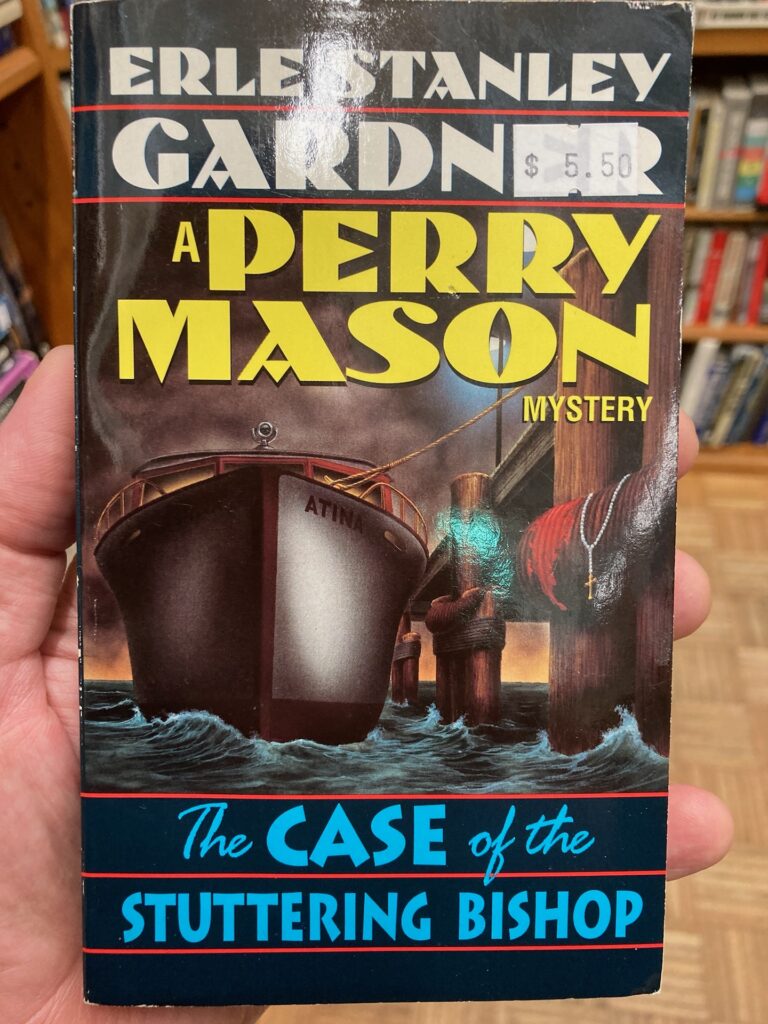
10. The Case of the Dangerous Dowager
Morrow: Apr., 1937
Recurring characters:
The only recurring characters are Perry Mason, Della Street, and Paul Drake. Since the case winds up in federal court, none of the regular Los Angeles prosecutors or police make an appearance.
We meet the U.S. Marshal for the region, who remains nameless; he is a “tall, raw-boned individual with a lazy drawl in his speech, a black sombrero on his head, and a manner of calm unhurried efficiency…” (ch. 8). He seems a worthy match for Mason, and we can only regret that he never appears in another Perry Mason novel.
Paul Drake makes a pass Della Street; she adroitly turns him down.
Plot devices:
The murder takes place on a gambling ship anchored beyond the twelve mile limit, thus placing it in federal jurisdiction.
This is a classic one-entrance-to-the-room mystery: with only one entrance to the room, and with that entrance watched by multiple witnesses, it seems clear that the attractive female defendant must be guilty of the murder. However, there is a walk-in safe in the room, and the murderer hides in that until his accomplice lets him out.
In another layer to the one-entrance-to-the-room plot device, the murder takes place on a ship with limited access via speed boat. However, this limited access proves illusory, since the crew lets people get into speed boats out of sight of the police, for a suitable bribe.
Legal matters:
The murder takes place outside the limit of California state. Therefore, it becomes a Federal case.
The case is about to go before a federal Grand Jury. Mason is not only subpoenaed, he is also accused of being an accessory after the fact. Before going into the Grand Jury room, the federal District Attorney has Mason and various other interested parties in his office; Mason solves the case in the Federal D.A.’s office.
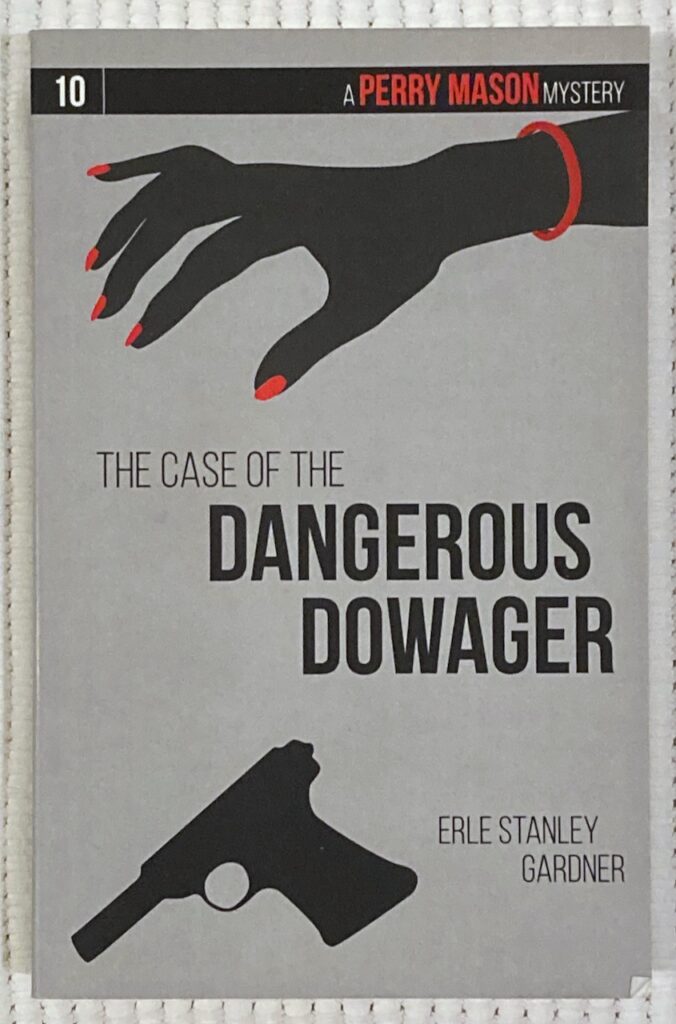
11. The Case of the Lame Canary
Serialized: Saturday Evening Post, May-July, 1937
Morrow: Sept., 1937
Recurring characters:
Plot devices:
Legal matters:
12. The Case of the Substitute Face
Morrow: Apr., 1938
Recurring characters:
Perry Mason and Paul Drake appear as usual. Since the trial happens in San Francisco, Drake has to join Mason and Street in that city; we don’t get to see the offices of either Mason or Drake.
In one plot twist, Della Street goes into hiding without telling Perry Mason or Paul Drake where she’s going. Needless to say, this worries the two men, though when Paul Drake tracks her down, it turns out that she had been a witness to the alleged murder, and hoped to avoid the attendant newspaper publicity.
Jackson appears in this book, promoted from law clerk to “office lawyer” (chapter 3). Jackson is described as having “studious eyes” and “tortoise shell glasses,” and Mason criticizes him for “not being a fighter” (chapter 9).
Plot devices:
The plot hinges on a murder allegedly committed on an ocean liner traveling from Honolulu to San Francisco. However, it turns out that shots were fired into a dummy, which was then thrown overboard. Carl Moar, the man who was supposedly murdered, then takes up a role as an invalid with a broken neck, many bandages, and dark glasses, who is wheeled about in a wheelchair; presumably the dummy that was thrown overboard was wheeled on board in the wheelchair (though this is never really explained; one of several plot holes).
The case is quickly brought to a preliminary trial, during which Mason shows, through some adroit cross examination of a key prosecution witness, that the prosecution cannot prove the corpus delicti. But after the ocean liner docks, and everyone gets ashore, Carl Moar is in fact murdered, his body taken out to sea, and placed in a life ring “which had been tossed overboard from the steamer the night before.” This plot does not stand up to close scrutiny: the various elements of the chronology don’t quite mesh; finding the appropriate life ring in the vastness of the ocean seems improbably at best; etc.
In a subplot, a wealthy-but-essentially-good young man is sought after by two women: the wealthy-but-scheming young woman, and the middle class-but-essentially-good young woman. In the end (of course), the essentially good young woman and the essentially good young man wind up getting married.
Legal matters:
The most interesting legal matter is Mason’s adroit cross examination of the key prosecution witness, making it impossible to prove the corpus delicti.
13. The Case of the Shoplifter’s Shoe
Morrow: Sept., 1938
Recurring characters:
Perry Mason and Della Street have a bit of a romantic scene on the last page:
“‘You mean she was mushy over the telephone?” Mason asked incredulously.
“‘Well, she was pretty sugar-coated, and just before she hung up, she…’
“‘She what?’ Mason asked.
Della Street laughed. ‘I couldn’t tell you,’ she said, ‘it would be betraying a sacred confidence.’
“‘Could you you,’ Mason inquired, ‘show me?’
“She paused long enough to make certain there was no one else on the driveway.
“‘Well,’ she conceded with a throaty laugh, ‘I might. Bend over so I can reach….'”
At the beginning of the book, Della Street makes a passing reference to “beetle-browed” Jackson, the law clerk.
Sergeant Holcomb gets into a fight in a hospital room (of all places) with the Sampson, the deputy district attorney:
“‘Shut up!’ Sampson said. ‘Can’t you see that you’d be playing right into their hands?’
“Sergeant Holcomb said, ‘I’ll show you,’ and swung.
“Sampson jumped back. [Dr.] Gifford said, ‘Gentlemen, I’m going to order hospital attendants to clear the room. This is a disgraceful scene, and it’s having a most harmful effect on my patient.'”
Plot devices:
Legal matters:
Sergeant Holcomb mixes up two key pieces of evidence — two bullets from two different guns. Mason, knowing that Holcomb would never admit to botching the evidence, brings out the truth of the matter through skillful cross-examination of another witness.
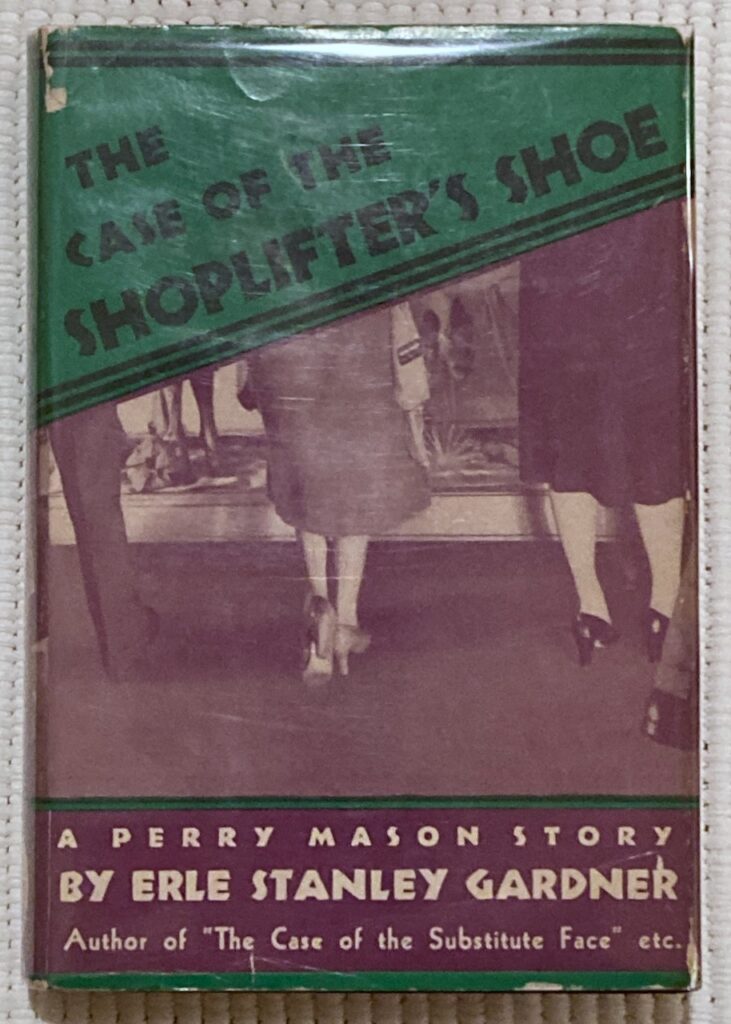
14. The Case of the Perjured Parrot
Morrow: Feb., 1939
Recurring characters:
Plot devices:
Legal matters:
15. The Case of the Rolling Bones
Morrow: Sept., 1939
I consider this one of the best of the Mason novels. Fast action, fun dialogue between regular characters, interesting background. There are the usual holes in the plot and loose ends at the close of the novel, but the strengths makes up for the weaknesses.
Recurring characters:
Gertie, the receptionist, is introduced in this novel when she sets a fire in a wastebasket to help Mason get out of a speeding ticket. Here’s how she’s described on her first appearance:
“Gertrude Lade, tall, thin as a rail, her figure angular, her face plain, too the glass of whiskey Mason handed her, grinned at them, and said, ‘Here’s regards.’ She tossed off the whiskey in a single swallow…. She turned and walked with long-legged strides through the door to the outer office.’
(In later books, Gertie is described as overweight.) Later in this book, Gertrude Lade makes an appearance in the courtroom, as Perry Mason corss examines a witness to test his recollection.
Perry Mason and Della Street have a romantic interlude while waiting late at night in the apartment of a key witness. Mason (sort of) proposes marriage to Street:
“They sat together by the little fireplace talking in low tones and waiting for the phone to ring. Perry Mason’s hand unconsciously sought Della Street’s, gently imprisoned the fingers. ‘Gosh, Della,’ he said, ‘I’m getting sentimental. It almost seems as though this place had been made of us.’
“She moved her other hand to gently stroke the back of his well-shaped, strong fingers. ‘Nix on it, Chief,’ she said softly. ‘You could no more live a domestic life than you could fly…. You might like a home for about two weeks, and then it would bore you stiff. At the end of four months, you’d feel it was a prison.’
“‘Well,’ Mason said, ‘this is part of the first two weeks.’
“It seemed but a few minutes before they heard the click of a key in the lock…. Della Street, with a quick intake of breath, said, ‘I don’t want her to see me until I powder my nose,’ and dashed for the bathroom.”
Neither Hamilton Burger, Arthur Tragg, nor Sergeant Holcomb appear in this book.
Plot devices:
Several of the characters in the story had been in the Tanana gold rush — not the Yukon gold rush, as they repeatedly have to explain, although a dance hall in Dawson, Yukon Terr., features in the story.
The plot hinges on a possible case of mistaken identity. Is Alden Leeds really Alden Leeds, or is he Bill Hogarty? Mason has to find out what happened in the Tanana to finally unravel the mystery.
The “rolling bones” in the title refer to loaded dice. One of the minor characters starts a company selling crooked dice, through which Mason and Paul Drake track down a woman who turns out to be an important figure.
Legal matters:
The doctor serving as the state’s autopsy surgeon determines the time of death to within a 45 minute period, based on when a meal was eaten by the deceased. On cross examination, Mason forces the doctor to admit that based on what he knows from doing the autopsy, he cannot fix the time of death that accurately — since the doctor does not know, of his own knowledge, when the deceased at that last meal:
“‘But all you know of your own knowledge, Doctor, is that you performed an autopsy on a body, that death had occurred from eight to fourteen hours prior to the time you made your examination and within approximately two hours of the time the deceased partook of a meal consisting of certain specific articles of food?’
“‘You can put it that way if you want to,’ the doctor snapped.
“‘Thank you, Doctor,’ Mason said with a smile. ‘I want to….'”
As it turns out, the doctor fixed the time of death incorrectly. Here again, Erle Stanley Gardner makes the point that circumstantial evidence can be misinterpreted.
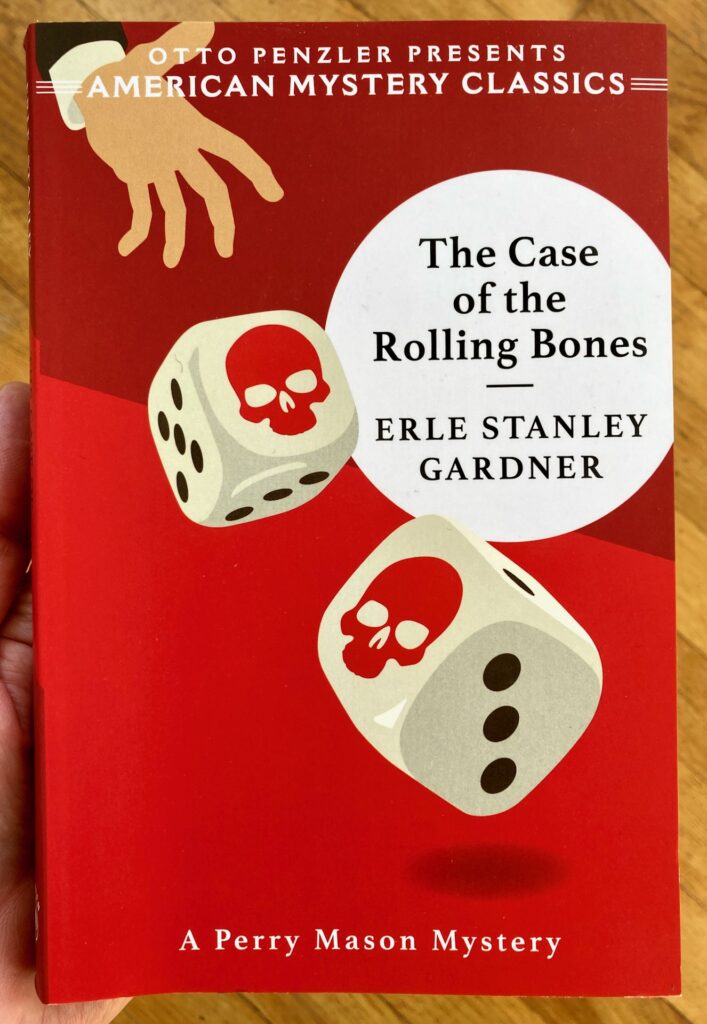
16. The Case of the Baited Hook
Morrow: Mar., 1940
Recurring characters:
In the last few pages, Perry Mason tells Sergeant Holcomb how to solve the case. Holcomb is initailly suspicious, but eventually takes Mason up on the offer. Mason even allows Holcomb to take full credit for solving the case, and Holcomb even thanks him:
“Surprised, Mason shook hands.
“Sergeant Holcomb said, ‘Don’t think for a minute this gives you any right to cut corners on your next case.’
“‘What does it give me?’ Mason asked, his eyes twinkling.
“‘My thanks for handing me a tip on a silver platter and for bringing a murderer to justice. Any cop worth his salt will respect a man who can do that.’…
“Once more Sergeant Holcomb strode across the office. Just before he jerked the door closed, he turned back to say to Mason, ‘I still don’t like your methods.’
“‘I understand,’ Mason said.
“Sergeant Holcomb’s glittering eyes held the lawyer. ‘And I don’t think,’ he went on, ‘that I like you.’
“The door slammed….”
Plot devices:
Mason is retained by a man who cuts a ten thousand dollar bill in two parts, gives one part to Mason, and gives another part to a masked woman. Mason is instructed to defend the woman from an unspecified criminal charge. When she needs his help, the woman will give Mason the other part of the ten thousand dollar bill and that will be his fee.
There’s also a questionalbe mining company (and its stock); and a young woman trying to break into high society (who turns out to be adopted).
Legal matters:
There is no courtroom scene in this book.
The law of agency makes up a key part of the plot. Mason deflates a stuffed-shirt corporate lawyer with a short lecture on agency:
“Mason said, ‘You might examine Restatement of the Law. Take for instance pages 309-310 of the volume on Agency and notice the illustrations therein cited as representing judicial applications of the doctrine that death prinicipal terminates the authority of the agent. I call your attention particularly to the following….'”
— and Mason goes on for another two paragraphs on the topic.
17. The Case of the Silent Partner
Morrow: Nov., 1940
Recurring characters:
Lieutenant Arthur Tragg appears for the first time in this novel: “Lieutenant Tragg said nothing but concentrated on driving in traffic. He was about Mason’s age. His features stood out in sharply etched lines. His forehead was high, his eyes keen and thoughtful, an entirely different type from Sergeant Holcomb. Mason, studying the profile as the car screamed through the streets, realized that this man could be a very dangerous antagonist indeed.”
Plot devices:
Legal matters:
18. The Case of the Haunted Husband
Morrow: Feb., 1941
Recurring characters:
Plot devices:
Legal matters:
19. The Case of the Empty Tin
Morrow: Oct., 1941
Recurring characters:
Plot devices:
Legal matters: There is no trial scene.
20. The Case of the Drowning Duck
Morrow: May, 1942
Recurring characters:
Plot devices:
The early 1940s saw the beginnings of widespread commercial availability of detergents in the U.S., and Gardner has one of his characters explain how a detergent can remove the oils on a duck’s feathers, thus causing the duck to sink and drown.
Legal matters:
21. The Case of the Careless Kitten
Serialized: Saturday Evening Post, May-July, 1942
Morrow: Sept., 1942
Recurring characters:
Plot devices:
Legal matters:
22. The Case of the Buried Clock
Morrow: May, 1943
Recurring characters:
Plot devices:
Legal matters:
23. The Case of the Drowsy Mosquito
Morrow: Sept., 1943
Recurring characters:
Plot devices:
The “drowsy mosquito” of the title is the humming sound made by an electric ultraviolet light source.
This is yet another murder that centers around mining, and the ultraviolet light is used surreptitiously by one of the characters trying to find evidence of a rich mine.
Legal matters:
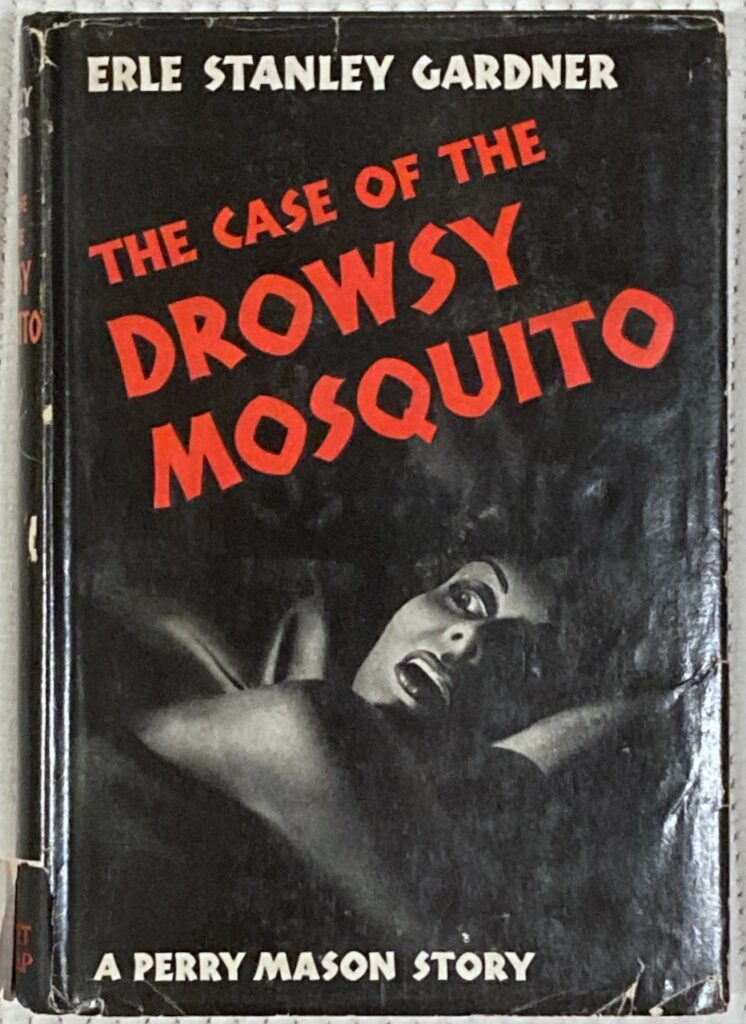
24. The Case of the Crooked Candle
Morrow: May, 1944
Recurring characters:
Plot devices:
A candle is attached to a table where a murder is committed, inside a sailboat. After the murder, the boat, which is aground, tilts with the tide and suddenly the candle no longer appears to be vertical. This bit of evidence allows Perry Mason to solve the mystery.
Legal matters:
25. The Case of the Black-Eyed Blonde
Morrow: Nov., 1944
Recurring characters:
Plot devices:
Legal matters:
Personal trivia:
This was the very last Perry Mason novel that I read. I found a copy at Pegasus Books on College Ave. in Oakland, started reading it, left it by mistake in the restroom of a sushi restaurant, but was able to order a copy online so I could finish the book.
26. The Case of the Goldigger’s Purse
Morrow: May, 1945
Recurring characters:
Plot devices:
Legal matters:
Personal trivia:
As near as I can recall, this was the very first Perry Mason novel I ever read.
27. The Case of the Half-Awakened Wife
Morrow: Sept., 1945
Recurring characters:
Plot devices:
Legal matters:
28. The Case of the Borrowed Brunette
Morrow: Nov., 1946
Recurring characters:
Plot devices:
Legal matters:
29. The Case of the Fan-Dancer’s Horse
Morrow: June, 1947
Recurring characters:
Plot devices:
Legal matters:
30. The Case of the Lazy Lover
Morrow: Oct., 1947
Recurring characters:
Plot devices:
Legal matters:
31. The Case of the Lonely Heiress
Morrow: Feb., 1948
Recurring characters:
Plot devices:
Legal matters:
32. The Case of the Vagabond Virgin
Morrow: July, 1948
Recurring characters:
Plot devices:
Legal matters:
33. The Case of the Dubious Bridegroom
Morrow: Feb., 1949
Recurring characters:
Plot devices:
Legal matters:
34. The Case of the Cautious Coquette
Morrow: May, 1949
Recurring characters:
Plot devices:
Legal matters:
35. The Case of the Negligent Nymph
Serialized: Collier’s, Sept.-Oct., 1949
Morrow: Jan., 1950
Recurring characters:
Plot devices:
Legal matters:
36. The Case of the One-Eyed Witness
Morrow: Nov., 1950
Recurring characters:
Plot devices:
Legal matters:
37. The Case of the Fiery Fingers
Morrow: May, 1951
Recurring characters:
Plot devices:
This book includes one of the worst plot devices ever used by Gardner. The characters in the book cannot figure out how fingers could glow in the dark, while the readers yawn and say to themselves, “Phosphorus.”
Legal matters:
38. The Case of the Angry Mourner
Morrow: Oct., 1951
Recurring characters:
Plot devices:
Legal matters:
39. The Case of the Moth-Eaten Mink
Morrow: Apr., 1952
Recurring characters:
Plot devices:
The solution to the plot requires Perry Mason and Della Street to figure out why someone let moths get into a mink coat. Della helps Perry understand a woman’s point of view on mink coats.
Legal matters:
40. The Case of the Grinning Gorilla
Morrow: Nov., 1952
Recurring characters:
Plot devices:
Legal matters:
41. The Case of the Hesitant Hostess
Morrow: Apr., 1953
Recurring characters:
Plot devices:
Legal matters:
42. The Case of the Green-Eyed Sister
Morrow: Nov., 1953
Recurring characters:
Plot devices:
Legal matters:
43. The Case of the Fugitive Nurse
Serialized: Saturday Evening Post, Sept.-Nov., 1953
Morrow: Feb., 1954
Recurring characters:
Plot devices:
Legal matters:
44. The Case of the Runaway Corpse
Morrow: June, 1954
Recurring characters:
Plot devices:
Legal matters:
45. The Case of the Restless Redhead
Serialized: Saturday Evening Post, Sept.-Oct., 1954
Morrow: Oct., 1954
Recurring characters:
Plot devices:
Legal matters:
46. The Case of the Glamorous Ghost
Morrow: Jan., 1955
Recurring characters:
Plot devices:
Legal matters:
47. The Case of the Sun Bather’s Diary
Serialized: Saturday Evening Post, Mar.-Apr., 1955
Morrow: May, 1955
Recurring characters:
Plot devices:
The plot devices, obviously meant to titillate the reader, include a young woman who is a nudist, and who lives alone in a trailer. There’s also a whiff of voyeurism: the young woman’s father is a convicted felon, the authorities are convinced the young woman is hiding his ill-gotten gains in her trailer, and it seems that the (male) authorities are monitoring the young woman’s behavior.
Legal matters:
48. The Case of the Nervous Accomplice
Morrow: Sept., 1955
Recurring characters:
Plot devices:
Legal matters:
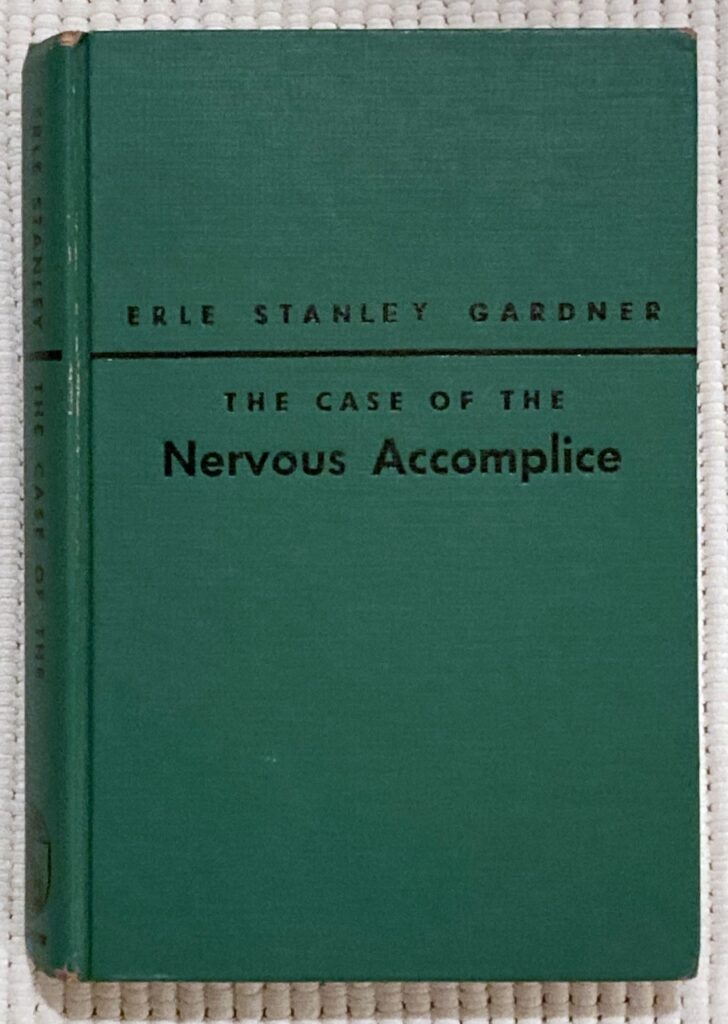
49. The Case of the Terrified Typist
Morrow: Jan., 1956
Recurring characters:
Plot devices:
Legal matters:
50. The Case of the Demure Defendant
Serialized: Saturday Evening Post, Dec., 1955-Jan., 1956
(Serial title: “The Case of the Missing Poison”)
Morrow: May, 1956
Recurring characters:
Plot devices:
Legal matters:
51. The Case of the Gilded Lily
Morrow: Sept. 1956
Recurring characters:
Plot devices:
Legal matters:
52. The Case of the Lucky Loser
Serialized: Saturday Evening Post, Sept.-Oct., 1956
Morrow: Jan., 1957
Recurring characters:
Plot devices:
Legal matters:
53. The Case of the Screaming Woman
Morrow: May, 1957
Recurring characters:
Plot devices:
Legal matters:
54. The Case of the Daring Decoy
Serialized by the Chicago Tribune/New York News, Sept.-Oct., 1957
(Serial title: “The Proxy Murder”)
Morrow: Oct., 1957
Recurring characters:
Plot devices:
Legal matters:
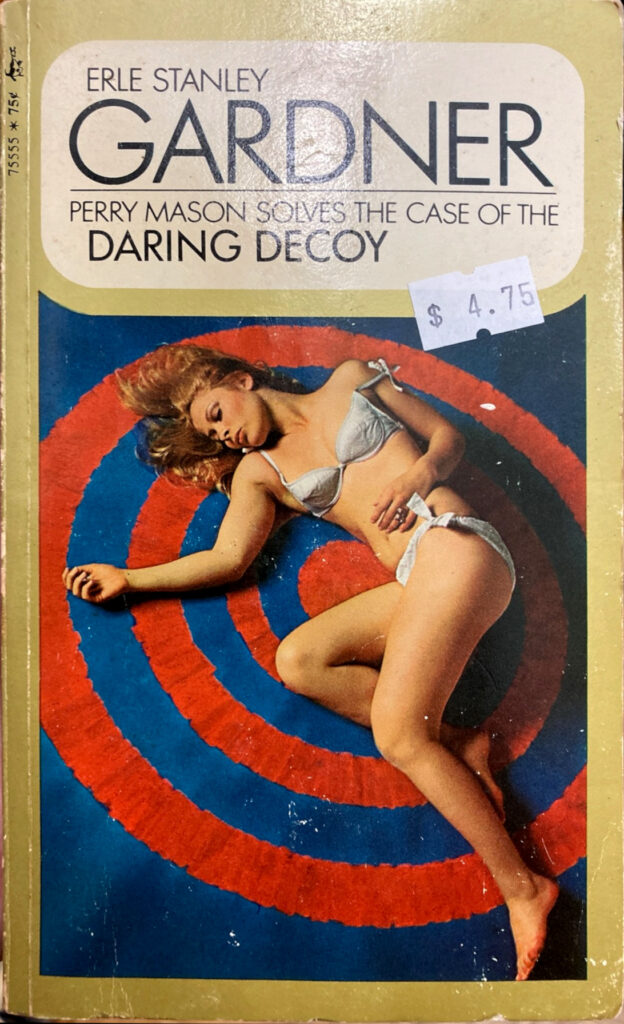
55. The Case of the Long-Legged Models
Serialized: Saturday Evening Post, Aug.-Sept., 1957
(Serial title: “The Case of the Dead Man’s Daughter”)
Morrow: Jan., 1958
Recurring characters:
Plot devices:
Legal matters:
56. The Case of the Foot-Loose Doll
Serialized: Saturday Evening Post, Feb.-Mar., 1958
Morrow: May, 1958
Recurring characters:
Plot devices:
Legal matters:
57. The Case of the Calendar Girl
Morrow: Oct., 1958
Recurring characters:
Plot devices:
Legal matters:
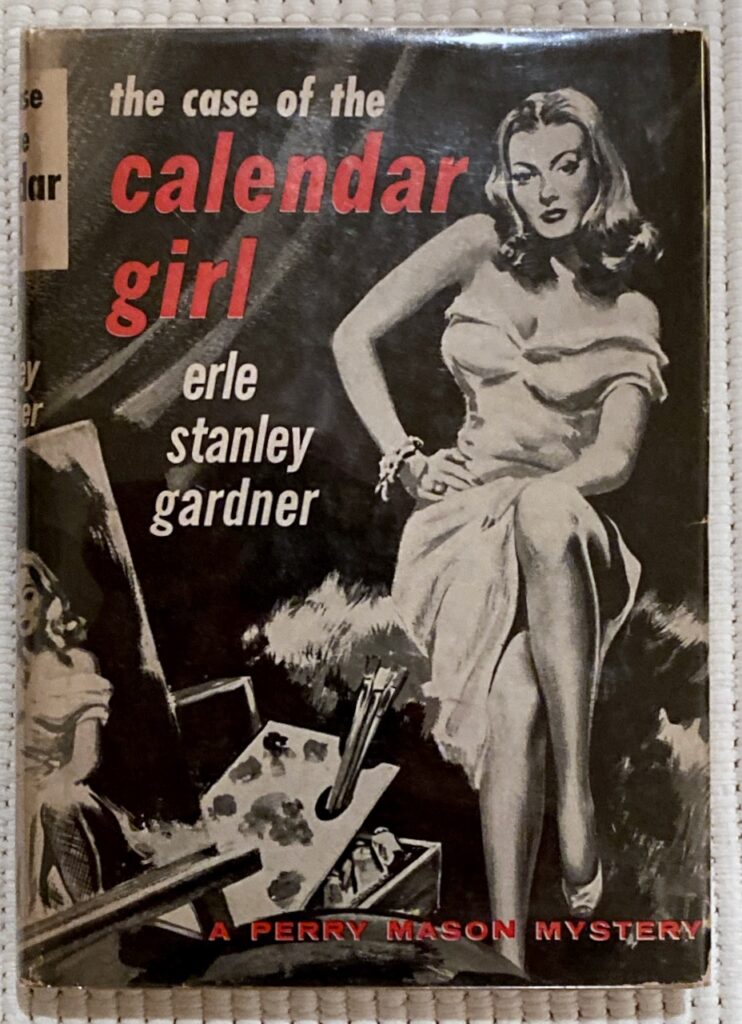
58. The Case of the Deadly Toy
Serialized: Saturday Evening Post, Oct.-Dec., 1958
(Serial title: “The Case of the Greedy Grandpa”)
Morrow: Jan., 1959
Recurring characters:
Plot devices:
Legal matters:
59. The Case of the Mythical Monkeys
Serialized: Saturday Evening Post, May-June, 1959
Morrow: June, 1959
Recurring characters:
Plot devices:
Legal matters:
60. The Case of the Singing Skirt
Morrow: Sept., 1959
Recurring characters:
Plot devices:
Legal matters:
61. The Case of the Waylaid Wolf
Serialized: Saturday Evening Post, Sept.-Oct., 1959
Morrow: Jan., 1960
Recurring characters:
Plot devices:
Legal matters:
62. The Case of the Duplicate Daughter
Serialized: Saturday Evening Post, June-July, 1960
Morrow: June, 1960
Recurring characters:
Plot devices:
Legal matters:
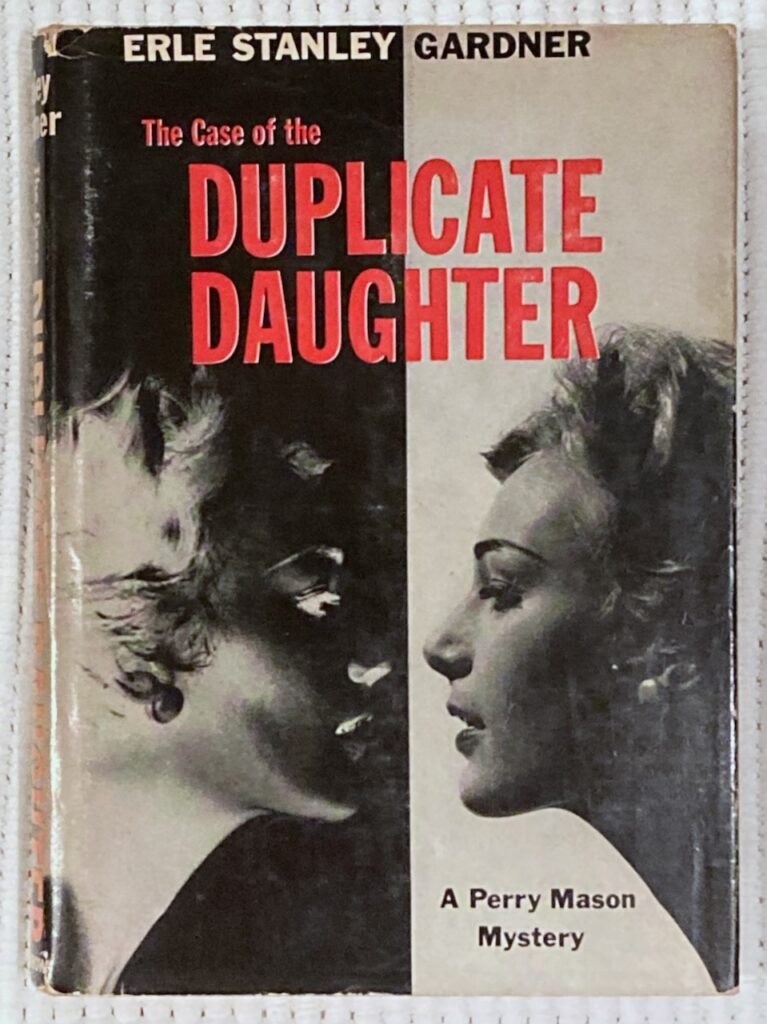
63. The Case of the Shapely Shadow
Morrow: Oct., 1960
Recurring characters:
Plot devices:
Legal matters:
64. The Case of the Spurious Spinster
Serialized: Saturday Evening Post, Jan.-Mar., 1961
Morrow: Mar., 1961
Recurring characters:
Plot devices:
Legal matters:
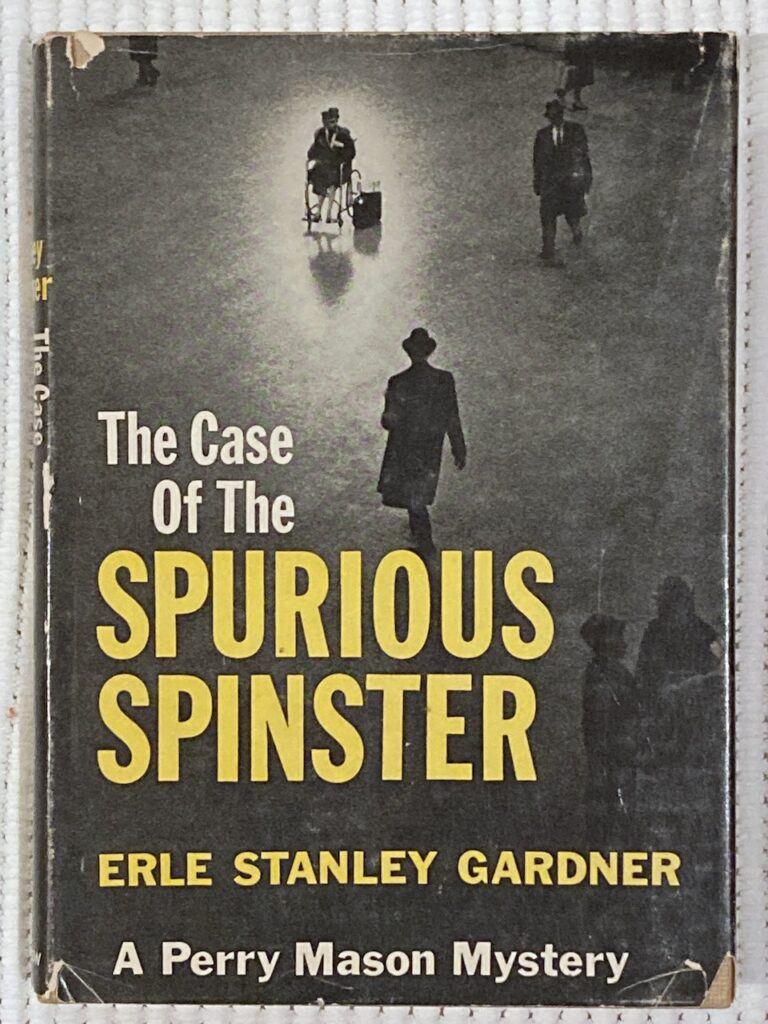
65. The Case of the Bigamous Spouse
Serialized: Saturday Evening Post, July-Aug., 1961
Morrow: Aug., 1961
Recurring characters:
Plot devices:
Legal matters:
66. The Case of the Reluctant Model
Published: Toronto Star Weekly, Oct. 7, 1961
(Periodical title: “The Case of the False Feteet”)
Morrow: Jan., 1962
Recurring characters:
Plot devices:
Legal matters:
67. The Case of the Blonde Bonanza
Serialized: Toronto Star Weekly, April, 1962
Morrow: June, 1962
Recurring characters:
Plot devices:
Legal matters:
68. The Case of the Ice-Cold Hands
Morrow: Oct., 1962
Recurring characters:
Plot devices:
Legal matters:
69. The Case of the Mischievous Doll
Published: Saturday Evening Post, Dec. 8, 1962
Morrow: Feb., 1963
Recurring characters:
Plot devices:
Legal matters:
70. The Case of the Stepdaughter’s Secret
Morrow: June, 1963
Recurring characters:
Plot devices:
Legal matters:
71. The Case of the Amorous Aunt
Morrow: Sept., 1963
Recurring characters:
Plot devices:
Legal matters:
72. The Case of the Daring Divorcee
Morrow: Feb., 1964
Recurring characters:
Plot devices:
Legal matters:
73. The Case of the Phantom Fortune
Morrow: May, 1964
Recurring characters:
Plot devices:
Legal matters:
74. The Case of the Horrified Heirs
Morrow: Sept., 1964
Recurring characters:
In chapter 22, Arthur Tragg trusts Mason enough to go along with him to interview a key witness; the case is solved. But we are assured that the police department will make sure Tragg winds up getting credit for solving the case (though Tragg himself is honorable enough that he will not try to grab the credit).
Perry Mason and Della Street have a mildly romantic interchange in chapter 20. Mason’s dialogue in this scene tends towards the stilted:
“‘Your hands,’ he said, ‘are wonderfully reassuring. You have competent hands, feminine hands but, nevertheless, strong hands.'”
Plot devices:
Legal matters:
75. The Case of the Troubled Trustee
Morrow: Feb., 1965
Recurring characters:
Plot devices:
Legal matters:
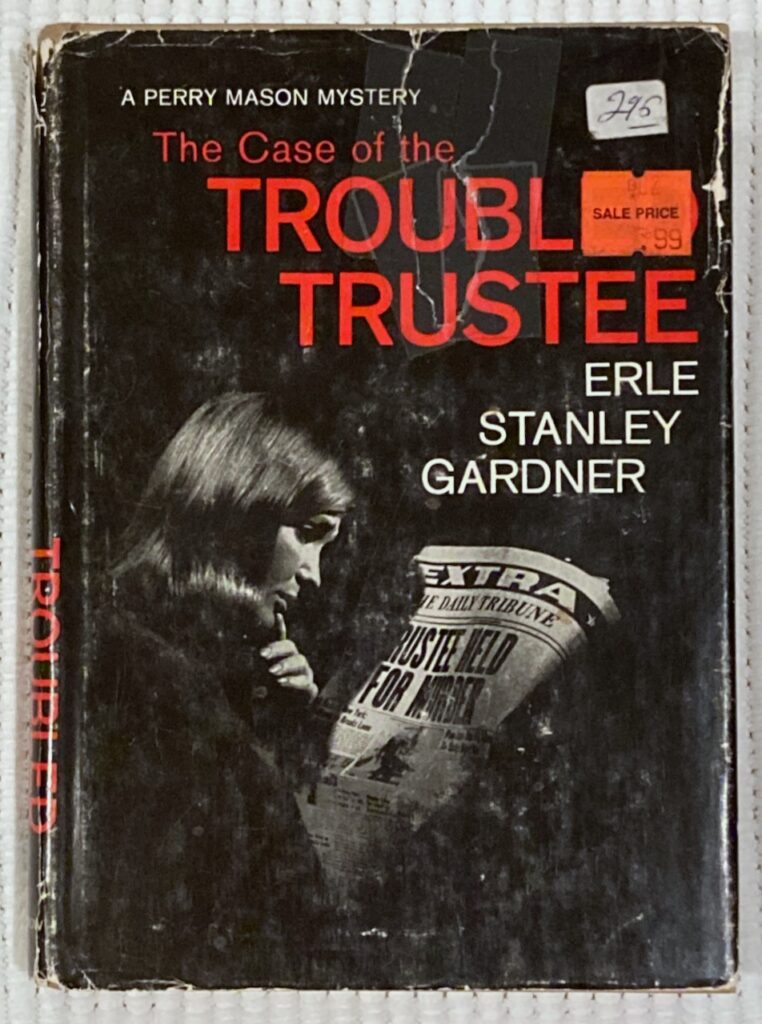
76. The Case of the Beautiful Beggar
Morrow: June, 1965
Recurring characters:
Plot devices:
Legal matters:
77. The Case of the Worried Waitress
Morrow: Aug., 1966
Recurring characters:
Plot devices:
Legal matters:
78. The Case of the Queenly Contestant
Morrow: May, 1967
Recurring characters:
Plot devices:
Legal matters:
79. The Case of the Careless Cupid
Morrow: Mar., 1968
Recurring characters:
Plot devices:
Legal matters:
80. The Case of the Fabulous Fake
Morrow: Nov., 1969
This is the last Perry Mason book Gardner wrote, though two other novels were published after his death.
Recurring characters:
Plot devices:
Legal matters:
81. The Case of the Fenced-in Woman
Morrow: Sept., 1972
Published posthumously. Gardner did not do a final revision of the book. In spite of that, this remains one of my favorite Mason books.
Recurring characters:
Plot devices:
Legal matters:
82. The Case of the Postponed Murder
Morrow: 1973
Published posthumously.
Recurring characters:
Plot devices:
Legal matters:
Shorter works
A. The Case of the Crying Swallow
The American Magazine, Aug., 1947
Recurring characters:
Plot devices:
Legal matters:
B. The Case of the Crimson Kiss
The American Magazine, June, 1948
Recurring characters:
Plot devices:
Legal matters:
C. The Case of the Irate Witness
Collier’s, Jan. 17, 1953
Recurring characters:
Plot devices:
Legal matters:
Recurring characters:
Perry Mason, lawyer
Della Street, Mason’s secretary
Gertie, or Gertrude Lade, Mason’s receptionist
Frank Everly, Mason’s law clerk
Jackson, Mason’s law clerk, later called “office lawyer”
Paul Drake, detective
Sergeant Holcomb, police officer
Lieutenant Arthur Tragg, homicide detective
Claude Drumm, chief trial deputy for the D.A.’s office (before Hamilton Burger)
Hamilton Burger, district attorney
References:
Breen, Jon L. Novel verdicts: a guide to courtroom fiction. Scarecrow Press, 1999.
Gardner, Erle Stanley. Perry Mason novels and stories.
Grost, Michael. “Erle Stanley Gardner.” http://www.mikegrost.com/gardner.htm accessed 16 November 2013.
Hughes, Dorothy B. The Case of the Real Perry Mason. Morrow: 1978.
Moore, Ruth. “Bibliography of Erle Stanley Gardner.” In Hughes, 1978.

Useful info, thanks. It would be nice if the Mason cases with DA Burger are listed separately. That is, Perry Mason books featuring Hamilton Burger himself and not his deputies
Sankaran, good suggestion. I actually have notes on some of that — I just have to find time to add those notes to this page.
I ran into this page, while searching for a Perry Mason book I read about 50 years ago. My English teacher advised I read Perry Mason books to learn English. I started reading most cases of Perry Mason’s and enjoyed thoroughly. Most of the book you listed are familiar to me.
However, I lost the book I was most impressed: I don’t recall the title or even the title started “the case of etc.” The story is: Perry Mason defended a young girl charged for murder: his asking price is $1: when he successfully defended the girl, she asked him why he undertook the case at such a low price, he said “You know, the best shing is always the cheapest.”
I started reading Perry Mason books and even to the National Library of Japan but still cannot find the book. When I asked AI (Microsoft’s Copilot), AI told me it’s “The case of the Shoplifter’s Shoe”. I read through the book but couldn’t find the phase I was looking for.
I would appreciate your answer to my question or advise how to pursue in the future. Any advice would be fine. Thank you!
Sonoe, I too am unable to find this phrase in “The Case of the Shoplifter’s Shoe.” I’m not able to read through all 85 Perry Mason novels, but nevertheless I’ll keep an eye out for this passage as I reread the books.